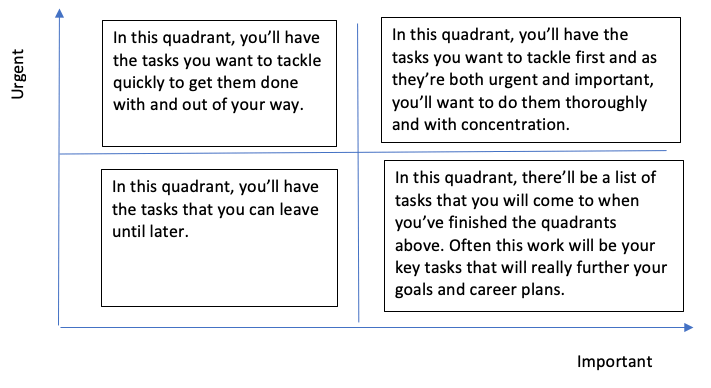This month I’d like to write about advice on reaching goals, as once you have set a goal, it can be easy to be distracted from completing it. Motivation can be strong to begin with and then it often can falter. Then there’s the danger of procrastination setting in.
Firstly, I’d like to talk about a really interesting book that I’ve been reading recently called ‘Tiny Habits’ by BJ Fogg. He is a researcher and has founded the Behaviour Design Lab at Stanford University and has been studying habits and how people can reach their goals for over 20 years.
He has come up with the formula below for changing habits:
Behaviour = Motivation + Ability (to do a task) + Prompts
How to increase motivation and avoid procrastination
Fogg talks about motivation and how this is the most difficult part of the equation to influence. It is easier to look at ability and to create what he calls a ‘tiny habit’. That is something that is easy to do (e.g. after finishing work for the day, tidy your desk by putting away one item). The prompt will be finishing work for the day. Once you get into the habit of doing something, then you can easily scale up that habit and grow it, so that in the example above you do a complete tidy-up.
He calls planning how you will create good habits ‘behaviour design’. The idea is that you try out the prompts that work and that you can design the environment (for the example above, give yourself a reminder at 5pm, or when you typically finish work) so that it makes the behaviour easier to do. You can also experiment with the prompts.
There’s a whole process to planning this behaviour design and I really recommend you getting the book if you would really like to use this in your life. You can use this technique with any behaviours that you would like to change in yourself. Some examples are from eating healthier and exercising more to being more productive at work by focusing more and not getting lost so much in distractions like social media etc.
Increasing motivation to reach your goals
As I mention above, motivation has been found to be one of the trickiest factors to try to increase. This is because it relies on will-power, which can be strong sometimes, but often may be weak. However, here are four tips that you might find helpful:
1. Plan ahead:
Try to tackle tasks when you won’t be tired, i.e. often the morning will be better. In Brian Tracey’s book ‘Eat that Frog’, he recommends that you choose the biggest, most difficult task to do, early on in the day, so that you get it done and over with when you are least tired. Getting tasks done will give you a dopamine hit and this can be motivating too.
2. Take small do-able steps:
Use the ‘tiny habits’ method. Also, part of this is about being kind to yourself. This will reverse your negative mood. Remember to celebrate after you have completed each small step. Make your habit (and hence your goals) something that you really want to achieve, try to make doing them as enjoyable as possible. For example, if it’s exercise that you want to increase, find something you find enjoyable. You can experiment a bit with this.
3. Get things done and don’t put them off until the future:
Following on from the above two bullet points, don’t falsely think that in a month, there will be more time, or that you will suddenly be able to become more productive in a few months’ time.
4. Be careful about how you think about your identity:
When you are engaging in a new habit, be open-minded about your identity. If you tell yourself you are the type of person who puts things off, then that identity will often be self-fulfilling. Try telling yourself a new story, that you are someone that gets things done and is proactive, or that you’re a fit person who exercises etc.
Intrinsic v extrinsic motivation
There has been a lot of research carried out that shows that intrinsic motivation is better, this is where you want to reach the goal for its own sake. Extrinsic motivation is where you the reason for completing the goal comes from outside (an example is if you do some work and the motivation for doing the work is money).
Even if you are being paid, refocusing the meaning behind why you want to complete a task is really important if you want to tap into that intrinsic motivation. Sometimes the goal in itself will not feel intrinsically motivating. Therefore, it’s good to separate the process from the goal.
So, try to make the process fun. If you are working with colleagues on a process, try to do this by approaching it in a light manner, or as an opportunity to socialise. An example of this is where you are at a trade fair to promote your company. Can you also chat to people while you are there and enjoy yourself as much as possible?
Another idea is to see if you are able to change your thinking about what you can get out of the process. An example is if you are on a course, think about how you are getting a lot out of the learning. This can be the case even if you felt obliged by your boss to go on the training day.
Avoiding procrastination
Procrastination can be defined as an unnecessary, voluntary delay in completing a task, whereby putting it off is going to adversely affect you. One of the reasons for procrastination is emotional – being in a negative mood. Often people will use this as a tactic to avoid a task, as they will say to themselves that they do not feeling like doing something. Therefore, this leads to them feeling like they are a failure. They put the task aside, but it’s still there, so it leads to more stress.
Brian Tracey, in his book ‘Eat that Frog’, talks about creative procrastination. After getting the biggest, most daunting task done (eating the frog), each day, you can allow yourself some procrastination time. Sometimes getting distracted by listening to an interesting podcast, or reading articles online is pleasurable and helpful. You don’t have to feel like you have to be working all the time. Work/life balance is also something to consider in the mix here.
Urgent and Important tasks exercise
Finally, I describe below an exercise that I’ve used and have adapted from Stephen Covey’s 7 Habits of Highly Effective People. It’s a useful way to sort out your tasks into what you feel you need to tackle first. It will help you to decide the order in which you complete things and therefore will help overall with reaching your goals.
First it will be good to create a to-do list of everything you would like to achieve. This could be work plans/ career goals. I don’t tend to use this exercise for non-work goals, but you could use it for this purpose.
Then you need to decide where each of the tasks fit within the graph below. You are looking at whether the task is urgent and/or important or not. I’ve written on each quadrant, how to tackle the tasks once you’ve decided where to place them.

Interested in another of Covey’s exercises? Why not look at the circles of concern exercise in my free resources page?
You may also like my blog on 5 tips on how not to be so busy.

